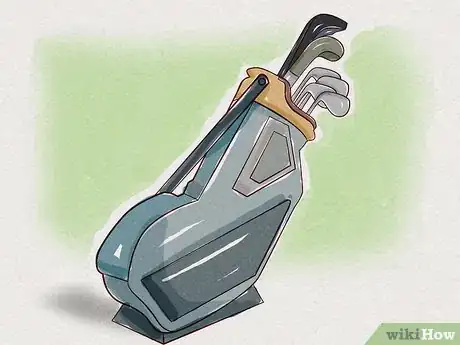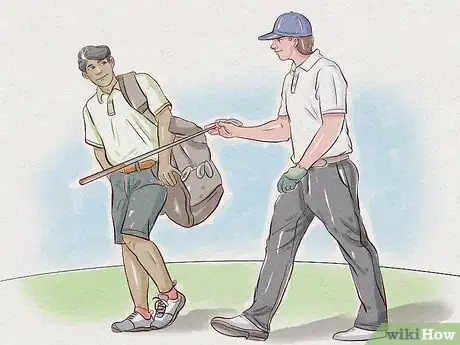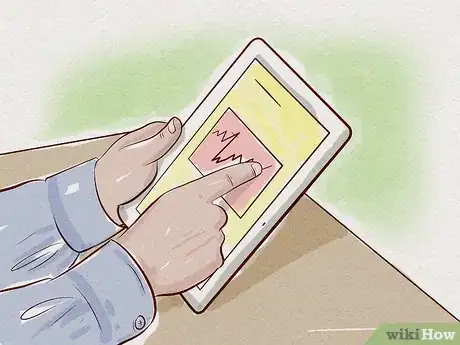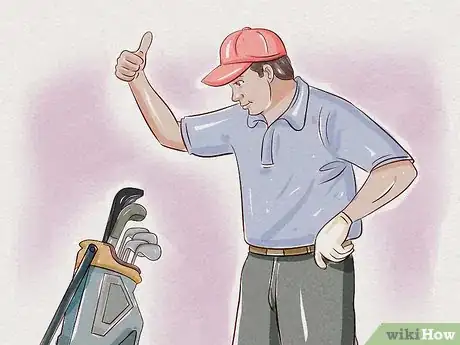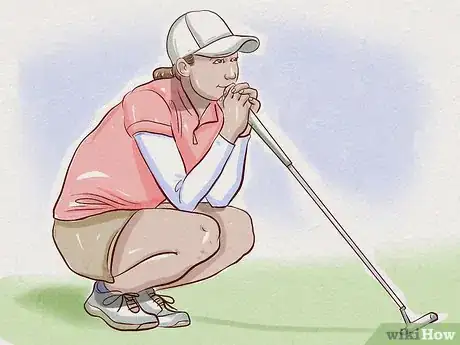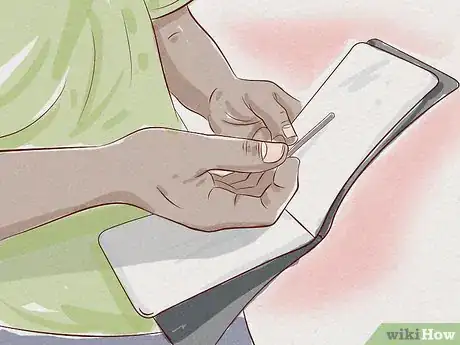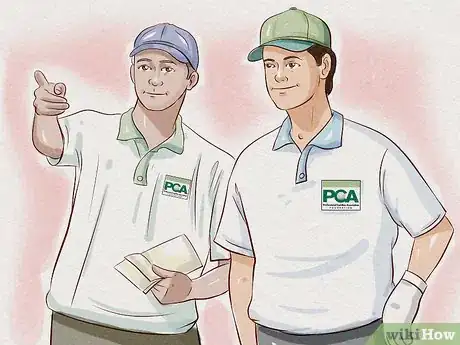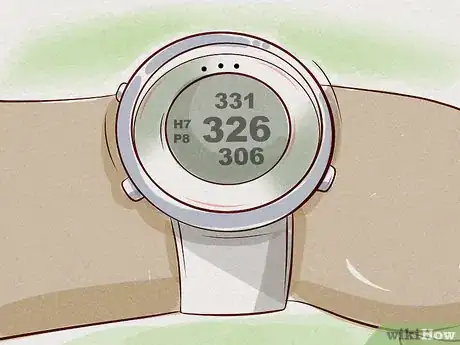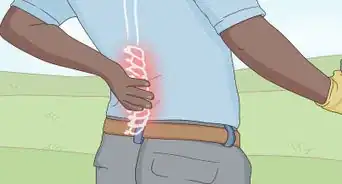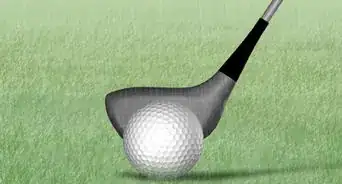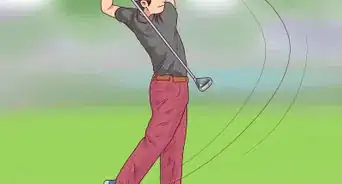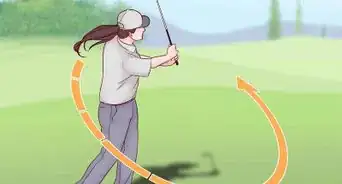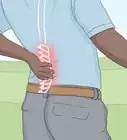This article was co-authored by wikiHow Staff. Our trained team of editors and researchers validate articles for accuracy and comprehensiveness. wikiHow's Content Management Team carefully monitors the work from our editorial staff to ensure that each article is backed by trusted research and meets our high quality standards.
This article has been viewed 99,402 times.
Learn more...
Being a caddy is more than carrying a bag around a golf course for 18 holes. Serving a golfer well in this capacity requires a solid relationship between the golfer and the caddy and an understanding of the game of golf. The golfer should be assured that the caddy is prepared, knows the game well, and offers sound advice. These traits only come from a caddy who is passionate about the game and ready to offer support at any level, on any course.
Steps
Assessing the Golfer's Needs
-
1Prepare the golf bag. There are certain items that your golfer will need for every round, and it's your responsibility to make sure the bag is properly stocked. If your golfer doesn't have everything required, it could adversely affect the game.[1]
- Check your golfer's bag for the appropriate golf clubs, new golf balls, extra gloves, towels, a yardage finder, a yardage book, bug spray, sunscreen, an umbrella, and a medical kit. You might also want to include a rain suit for both of you if the weather is questionable.
-
2Anticipate your golfer's needs. The best caddies know what a golfer requires. Keep the golfer hydrated, as cool or dry as possible, and know which club is necessary for the next hole. Be able to distinguish each club and be ready to offer a couple of different solutions for each of the golfer's obstacles throughout the game.
- Be sure to carry a towel at all times, since it will be your responsibility to clean the golfer's clubs and balls during a game.
Advertisement -
3Learn everything you can about golf. The more knowledgeable you are about the game, the more of an asset you will be to your golfer. Watch golf, read about golf, play golf, and breathe golf. Visit various courses and talk to other caddies about their experiences.[2]
- You can use networking experiences as a resource for learning more about golf and becoming an overall better caddy.
- Ask caddies questions such as: "How comfortable are you with that club?" Offer suggestions, but get to know your golfer's communication preferences. Some golfers will want your advice often while others prefer to make their own calls and have very specific preferences.
Being a Support System
-
1Be assertive. Caddies need a certain amount of confidence in their knowledge of the game. It's acceptable to stop a golfer from swinging if you disagree with a club choice or if you sense the wind about to change. A golfer will be more at ease if he or she knows they can rely on their caddy.[3]
- Never speak during a golfer's swing. Offer advice before they are teeing up and say something along the lines of, "I think this club would be very effective here" or "Stay wary of this sudden breeze." Some golfers will prefer that you stay out of the way and let them play, but others will love your words of encouragement.
-
2Remain positive. Golf is a game that requires intense concentration and a positive attitude on the part of the player. If your golfer is experiencing a few bad holes, it's your job to boost morale, help the golfer stay focused, and offer words of encouragement when they are most needed. If a golfer blames you for a poor game, you must remain calm and collected.[4]
- If your golfer hits above par, say: "Your next hole will be better. Just stay focused. You've got this." Even if you need to critique your golfer or offer advice, try to stroke their ego so they can become more confident in their strokes!
-
3Give pep talks. When a golfer is hitting over par, they may become frustrated. In order to ease their tension and keep them focused on their game, offer them words of encouragement and motivation. Learn how to communicate with your golfer in the most effective way; each golfer responds differently to advice. Never talk during their backswing.[5]
Mastering the Course
-
1Get to the course early. If you are one of the first caddies to show up to the course, you are far more likely to get the chance to caddy for a golfer hitting the course early in the morning. Promptness indicates to the golfer that you are professional and prepared. You never know who could be getting ready to tee off, so never miss out on such an opportunity.[6]
-
2Learn the yardages of the course. A caddy needs to know the yardages of the holes, referring to the yardage book when necessary in order to help the golfer choose the right club for each hole.[7]
- Knowing the yardages isn't always enough, and the caddy has to take the distances into account with weather conditions, course conditions and lie.
-
3Join the Professional Caddies Association (PCA). If you are serious about your role as a caddy, this program can help you become professionally trained and certified. You will be able to learn your local course along with other major and nearby courses. There are also special benefits that come with such an exclusive membership, such as the potential to meet and work with exciting professional golfers at the top of their game [8]
-
4Stay alert to changing weather patterns. The wind and the elements can affect the golfer's game, so be ready to provide any information that is relevant. Play in various weather situations yourself to get a better idea of how this can affect one's swing.
Community Q&A
-
QuestionWhere does a caddy stand during a shot?
 Community AnswerMake sure not to stand in between where the golfer is and the hole. Also keep your shadow out of the way of his line.
Community AnswerMake sure not to stand in between where the golfer is and the hole. Also keep your shadow out of the way of his line. -
QuestionCan I be a caddy if I am a teenager?
 Community AnswerYes. At most places, caddies start at around age 14. However, some people may rather have more experienced or older caddies.
Community AnswerYes. At most places, caddies start at around age 14. However, some people may rather have more experienced or older caddies. -
QuestionWhat are the club names in golf?
 Community AnswerThe most common ones are the drivers and the putters. Putters are used when on the green, areas that are close to the hole. Drivers are used at very long distances, and are usually the second least lofted club. Something with high loft has more of an angle, while lower lofts are straighter. Wedges are used for chipping or pitching. That's when you're close to the hole but not on the green. There are four types, sand wedge, gap wedge, pitching wedge, and loft wedge. The next group is the irons. That includes 9 irons, going down all the way to about 4. After that are fairway woods, which are between irons and drivers.
Community AnswerThe most common ones are the drivers and the putters. Putters are used when on the green, areas that are close to the hole. Drivers are used at very long distances, and are usually the second least lofted club. Something with high loft has more of an angle, while lower lofts are straighter. Wedges are used for chipping or pitching. That's when you're close to the hole but not on the green. There are four types, sand wedge, gap wedge, pitching wedge, and loft wedge. The next group is the irons. That includes 9 irons, going down all the way to about 4. After that are fairway woods, which are between irons and drivers.
Warnings
- Expect extreme weather when you work as a caddy. This is an all outdoor job and played in temperatures. If you can handle carrying a golf bag for 18 holes in those conditions, you're a good candidate for a caddying job.⧼thumbs_response⧽
References
- ↑ http://golftips.golfweek.com/tips-being-golf-caddy-1889.html
- ↑ http://golftips.golfweek.com/become-professional-golf-caddy-1888.html
- ↑ http://golftips.golfweek.com/golf-caddy-tips-1886.html
- ↑ http://collegeofgolf.keiseruniversity.edu/do-you-have-what-it-takes-to-become-a-pro-caddy/
- ↑ http://www.thegolfvillage.co.za/golf-etiquette-beginners-guide-lesson-1-dont-talk-someones-backswing/
- ↑ http://blog.golfsmith.com/guides/how-to-become-a-golf-caddie/#.WSaSe1KZNsY
- ↑ http://collegeofgolf.keiseruniversity.edu/do-you-have-what-it-takes-to-become-a-pro-caddy/
- ↑ http://blog.golfsmith.com/guides/how-to-become-a-golf-caddie/#.WSaSe1KZNsY
